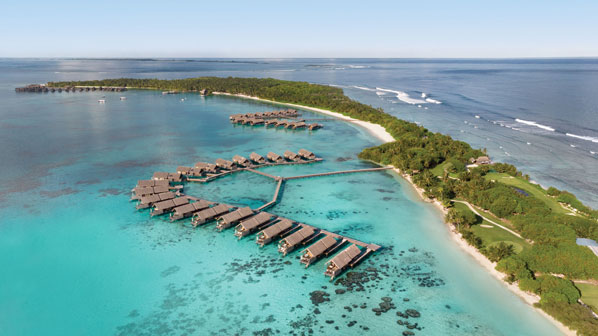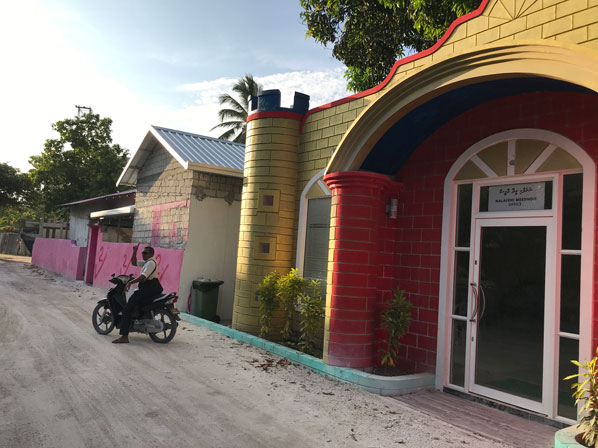On a remote coral island in the Maldives, Hannah Stephenson discovers a rural community which has turned its sandy landscape into a farming haven.
Maldivian farmer Ali cuts open a heavy, juicy watermelon from his plot of land, proudly presenting us each with a slice, juice dripping, still warm from the sun.
Standing on his small farm in Meedhoo, an island within the Addu Atoll, the southernmost group of islands in the Maldives – next stop Antarctica – you could be a million miles away from the luxurious five-star resorts complete with picture postcard white beaches, aquatic lagoons, over-water villas and swaying coconut palms synonymous with these islands.
Walking past a corrugated shack, which doubles as his shed, Ali proudly shows us his farm, which looks a bit like a huge allotment.
Watermelons and honeydews are ripening on the ground in the sun, many of which serve the discerning clients at the nearby deluxe Shangri-La’s Villingili Resort & Spa on neighbouring Villingili Island.
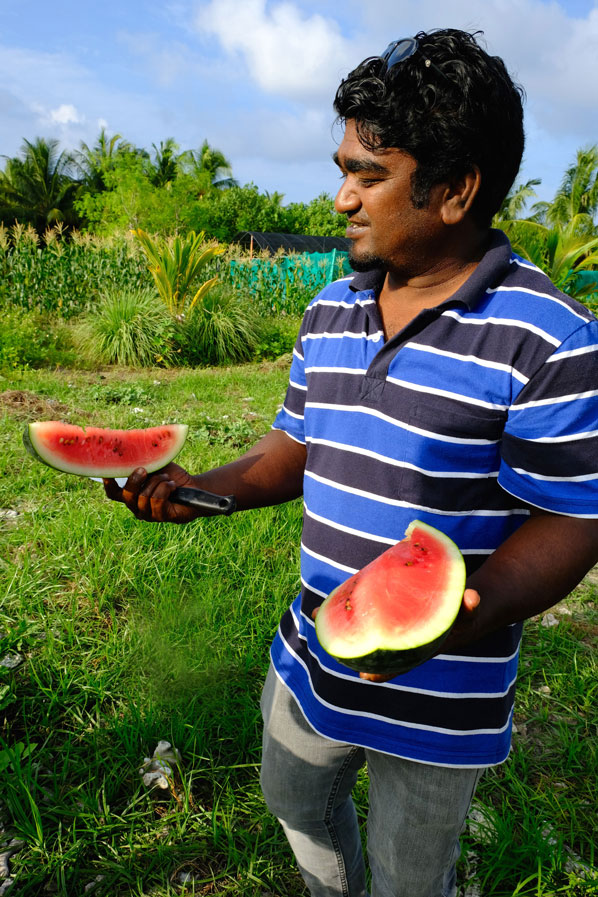
Ali is one of 50 farmers on Meedhoo who have helped form a cooperative to clean up their land and make it more productive, in partnership with the Shangri-La group, and tourists are now being offered the chance to see how this partnership is working in a new farm-to-plate experience.
Since the tourist boom of the 1970s, hotel-islands (there’s only one resort hotel or complex per island in the Maldives) were originally developed with the aim of keeping Western visitors separated from the Muslim localities.
But trends are changing and, despite the continuing political unrest of this nation, tourists are growing more curious about local communities and their cultures, seeking more authentic travel experiences.
The location of Shangri-La’s Villingili Resort is not only ideal for the luxurious fly-and-flop break, where tourists can boast that they’ve crossed the Equator, spotted turtles, seen manta rays and prolific pods of spinner dolphins or enjoyed a round of golf, but being close to the other islands which form the Addu Atoll also allows easy access to an insight into local life.

Once you’ve had a few days to wind down and admire the glorious vista of the turquoise Indian Ocean, the sublime white beaches and the sumptuous accommodation, you may want to sample a true taste of Maldivian life.
A 10-minute speed boat trip takes us to Meedhoo Island, which spans 2km x 2.5km, where we are presented with garlands of frangipani and bougainvillea by beautiful Maldivian children dressed in traditional Dhiveli libaas, dresses with ornate necklines made from traditional weaving, watched proudly by their hijab-clad mothers.
Meedhoo is clearly new to tourism. Only a few years ago, the small beach on which we are standing was a rubbish dump awash with plastic bottles, rusty cans and other debris, a makeshift landfill from its 3,500-population.
Today, thanks to the work of concerned members of the community who formed an NGO to clean up their island and educate adults and children in all matters of eco-friendliness, there’s not a plastic bottle or bag in sight. Adults and children still take part in regular beach cleans three years on and a local waste management company removes the rubbish.
Here, female tourists are politely asked to wear attire which covers their shoulders and knees in respect of the Muslim faith.
Driving on the sandy road past 900-year-old Koagannu, the oldest cemetery in the Maldives, we come across an impressive school hidden behind bright blue walls, while a peppering of stylish gated houses in subtle shades of lemon clash with nearby tired, older buildings with corrugated roofs and fading pink painted walls. Traditional houses used to be made of corals but, of course, that doesn’t happen anymore.
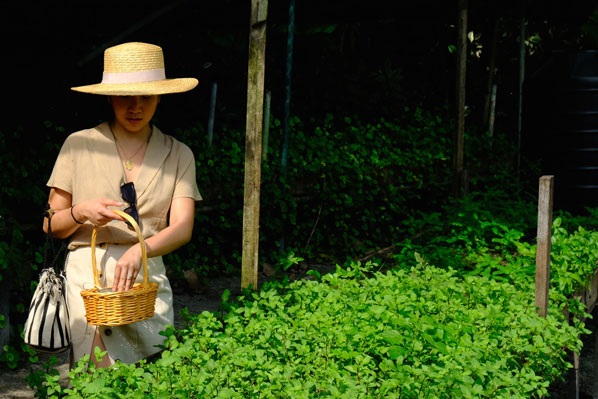
By the look of things, tourism has clearly helped some prosper on Meedhoo but has been slower to transform life for others.
With a population of 3,500 to feed, farming has always been big here but now it’s bigger. On one farm, we walk past deep troughs of leafy Chinese cabbages, huge banana trees and beds of yam, whose voluminous leaves are known as elephant ears, and are asked to remove our shoes before entering a large greenhouse filled with rows of lofty cucumber plants bearing dangling ripening fruits.
It’s one of four greenhouses made possible through a $15,900 (approx £12,200) loan in 2013 from the Shangri-La group to the cooperative, which has helped increase farming production massively, so much so that Meedhoo and its neighbouring islands in the atoll now provide the resort with around 15% of its fruit and vegetables. The farmers paid back the cost of the greenhouses within 10 months, which was deducted from the resort’s weekly supply.
Hot Maldivian chillis, papaya, bananas and a variety of salad leaves are flourishing on the cultivated land. Fragrant frangipani, bougainvillea and other flowers grown on the island also serve the resort.
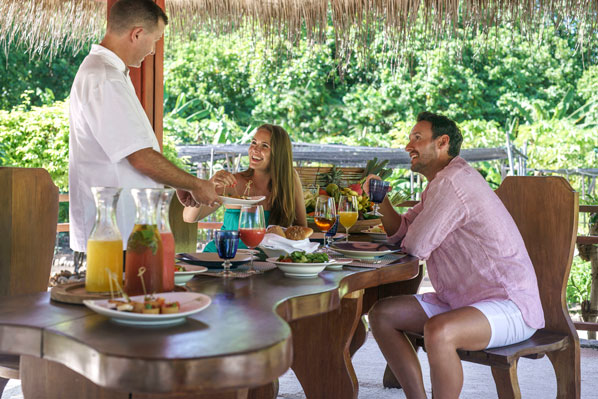
So how can they grow such rich produce on a bed of coral sand?
Rotten leaf matter on the island is broken down to make soil richer, although compost also has to be imported from Sri Lanka and India to beef up the terrain, while great tanks gather rainwater for the crops.
And while problems of whitefly, thrips (an insect) and mites sometimes threaten the harvest, the biggest challenge for farmers is the changing weather patterns resulting in a longer rainy season, says the community environmental officer Mohamed Kamir.
But efforts are being made to expand the types of crops which may be able to cope with changing weather conditions.
Earlier in the day, we visited the resort’s own chef’s garden to pick vegetables and herbs to use in our dishes at dinner.
There’s an abundance of mint, dill and basil, as well as gourds, aubergines, courgettes and spring onions, Chinese cabbage and rocket, all of which provide some of the resort’s needs.
If the chef’s garden cultivates a new variety successfully, it will teach the Meedhoo farmers how to grow and care for the plants, so that they can expand their own crops.
So, as we sit down to our delicious farm-to-plate dinner in stylish settings on Villingili later that evening, featuring locally-caught wahu carpaccio, meaty tuna with lemongrass veloute with some of the herbs and vegetables we picked earlier in the chef’s garden, and fruit cocktail with mango soup courtesy of the farmers of Meedhoo, nothing could really taste sweeter.
